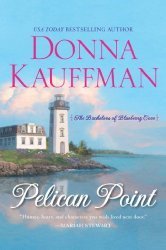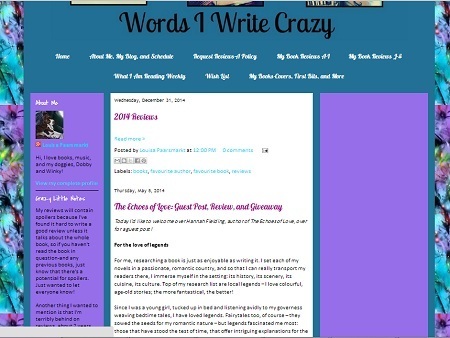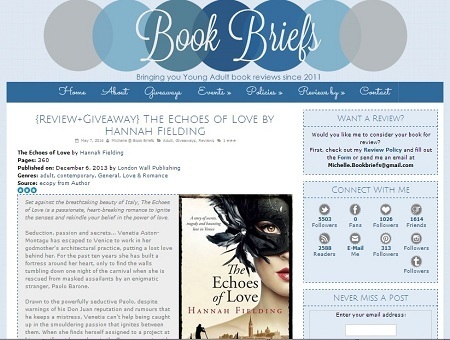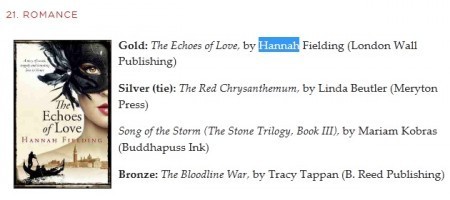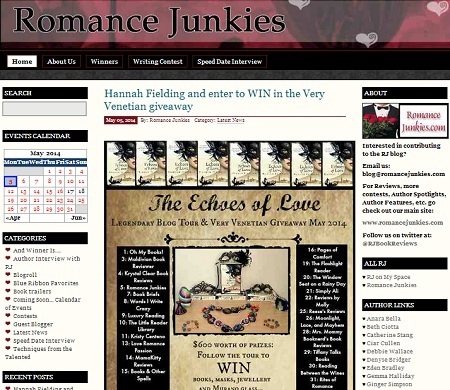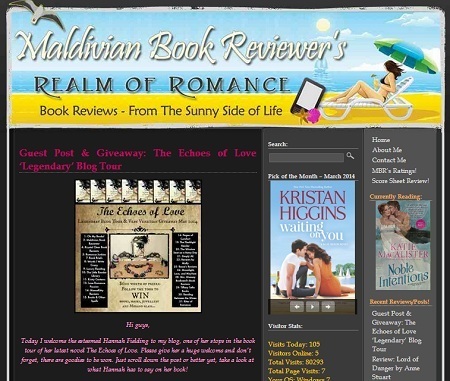Hannah Fielding's Blog, page 104
May 9, 2014
Book review: Pelican Point by Donna Kauffman
From the blurb:
Blueberry Cove, Maine, is as small-town as small towns get. More than a little quirky, it has sheltered generations of families. But there’s always room for a new face…
Fixing things has always been Alex McFarland’s greatest gift and keenest pleasure. But with her own life thoroughly broken, she’s signed on to renovate the dilapidated Pelican Point lighthouse, hoping to reconnect with herself. The last thing she expects is to find herself falling in love–with the glorious coastline, with age-old secrets and welcome-home smiles…with rugged Logan McCrae, the man she just might be able to build new hopes on.
Given that my own career background is in restorations (running a cottage restoration business), I expected to find an affinity with this book and so was keen to read it. The book didn’t disappoint, with plenty to interest those who, like me, find restoration fascinating. But there was so much more to like in the book too!
The opening is really quite dramatic, and it hooked me in at once. I loved the characters, and quickly connected to them. There is so much depth to the characterisation, and so much pain in Alex, particularly, that a reader is hard pushed not to feel empathy and want to follow the journey from lost to found. The backstories on both the main characters are compelling and well explored, and the characters’ actions and reactions in view of their pasts felt realistic to me. I really liked the fact that the author wasn’t afraid to probe deeply into their emotions, which created a big emotional attachment in me as I read.
The romance is passionate, fun and poignant in equal measure. I loved the realism inherent in it – the fact that the author does not wait until the very end to bring the characters’ together, but depicts a more typical, real-world romance in which two characters stumble along, ‘winging it’, uncertain and frightened to let go of the past and move forwards.
I loved the slight edge of mysticism in the book; the idea that ‘change is coming’ and that Alex’s presence in Blueberry Cove (wonderful name!) is predestined. There’s also a good deal of quirkiness, which is appealing – and I really warmed to the community aspects of the story. Don’t we all feel a pull towards a fictional world in which a small town takes in a lost sheep and becomes a new and accepting family?
Overall, this book felt to me like wrapping up in a soft blanket on a wintry day – comforting and heart-warming. Certainly one to read to restore your faith in love, life and finding a place to belong.
I was offered this book in exchange for a fair review via NetGalley.
Pelican Point is available now from Amazon; click on the book cover below to visit the store.
May 8, 2014
Win today with Words I Write Crazy on my ‘Legendary’ Blog Tour & Very Venetian Giveaway
Please visit http://writingcrazyme.blogspot.co.uk/2014/05/the-echoes-of-love-guest-post-review.html and comment for your chance to win today, and to read about the legends of the gondola…
May 7, 2014
Free abridged version of The Echoes of Love in BN Magazine…
For UK readers, pick up a copy of BN magazine from your local Bon Marche store for a free abridged version of The Echoes of Love…
Win today with Book Briefs on my ‘Legendary’ Blog Tour & Very Venetian Giveaway
Please visit http://bookbriefs.net/2014/05/07/reviewgiveaway-echoes-love-hannah-fielding/and comment for your chance to win today…
Five things to love about Revenge
I was a teenage girl when I discovered television drama. Such a discovery! My mother and my sister and I would sit together gripped by the likes of Dallas and Dynasty. I loved the settings, the intrigue, the romance, the passion – but most of all, the dramatic nature of it all!
In recent years, the kind of ‘high drama’ embodied in such television series has waned in popularity a little, I think. Networks seem to commission more ‘real’ dramas – some of which I enjoy; some of which I find too gritty to provide the escapism I seek in an hour of television viewing. But then along came Revenge…
A newspaper reviewer wrote of my first novel that it is ‘romance like Hollywood used to make’. I’ve always appreciated that comparison, and I extend it now to Revenge: it’s television drama from ‘the good old days’, only set in the modern time.
Here, for fun, I’m sharing five things I love about Revenge:
The setting: The action focuses on very rich Americans, and I love the grandeur of their world: the yachts, the vast houses, the cars, the artworks, the parties. I think the cleverness of the show is that it gives a glimpse into this world without showing it as idyllic. Money doesn’t buy happiness (but it does buy a house the size of a shopping mall on a private beach!).
The characters: I really enjoy the characterisation on this programme, and I think many of the actors are superb in their roles. What stands out to me is the exploration of dark and light in each person: there is yet to be a character who does not have to touch on their shadow self in the need for either vengeance, self-protection or self-advancement.
The costumes: I would watch the show for these alone! What a budget they must have for costumes. The women’s attire in particular is beautiful. Stunning dresses. My favourite scenes are those in which the characters are attending a function of some kind; the formalwear is exquisite. This really is a show for fashionistas!
The twists: I’ve given up trying to work out where the story is going; I simply sit back and enjoy the many twists and turns of the plot. I love the constant sense of mystery, and I think the writers do an amazing job of knitting together a complex story. Where will it end? I’d say ‘I can’t wait to see’, but I can – I don’t want the story to finish.
The passion: There is so much passion in the programme – I find it compelling and moving, especially the passion of the characters seeking vengeance. There are shades of the age-old melodrama style here, and I love that. Clearly I’m not in a minority, because nearly nine million people tune into the show in the US alone!
If you’ve seen Revenge, I hope you’ll appreciate my post – can you add to my list? What do you love about the show? If you haven’t, I hope I’ve encouraged you to give it a try. To whet your appetite, here’s a promo for one of my favourite episodes – it is set at a masquerade ball, which of course appeals to me given that I open the action of The Echoes of Love at just such a sumptuous and grand ball…
May 6, 2014
The Echoes of Love wins a Gold award…
I’m delighted to share that my latest novel, The Echoes of Love, has won a gold award in the 2014 Independent Publisher Book Awards!
The lion of Venice
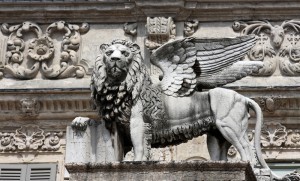 Did you know that the symbol of Venice is a winged lion? You’ll find it all over Venice, in statues, on flags – it’s at the very heart of the city.
Did you know that the symbol of Venice is a winged lion? You’ll find it all over Venice, in statues, on flags – it’s at the very heart of the city.
The lion is a representation of the Venetian patron saint, St Mark. So legend tells, St Mark travelled to Venice in his lifetime whereupon an angel told him, ‘May peace be with you, Mark, my evangelist. Here your body will rest.’ Venetians later took this prophecy to heart when they stole Mark’s remains from Egypt and interred them in the Basilica (see my earlier blog ‘The very bones of Venice: Saint Mark’).
Why a lion specifically? And why winged? In Christian iconography the lion is one of the symbols representing the four evangelists. The lion conveys power (of the Word coming via the evangelist) and its wings tell of spirituality – a heavenly beast.
You find lions everywhere in Venice, from ornate carvings in architecture to the beast fluttering on the flags. The Venetian lion is often depicted with water, to represent the city’s strong relationship with the ocean; in some statues it is in moleca, crab-like.
In St Mark’s Square stands the most famous Venetian lion: a bronze sculpture atop a granite column dating back to the 12th century. (On the other column stands Venice’s original saint, Theodore of Amasea, on a crocodile, to represent the dragon he is supposed to have slain.) Interestingly, elements of the Mark statue date back to the beginning of the 3rd century BC in the Greek world; at some point the statue was refashioned to represent Mark, possibly as late as 1293, when its restoration was first recorded. Certainly, the statue had become symbol of Venice by 1797, because Napoleon seized it after his conquest of the Venetian Republic and brought it to Paris. Thankfully, the Venetians reclaimed their precious icon, and it now stands proudly looking its domain: the square that is ‘the most beautiful drawing room in Europe’ and, beyond, a city whose ideals most definitely live up to the emblem of the lion: majestic, strong, passionate.
May 5, 2014
Win today with Romance Junkies on my ‘Legendary’ Blog Tour & Very Venetian Giveaway
Please visit http://www.romancejunkies.com/rjblog/?p=7046 and comment for your chance to win today, and to read about the ‘Janas of Sardinia’ legend…
May 3, 2014
Words interrupted: Completing unfinished books?
 The BBC News magazine recently published an interesting article entitled, ‘Should unfinished works be left untouched?’ The article was inspired by a new adaptation of a novel that was left unfinished upon the death of Charles Dickens: The Mystery of Edwin Drood. To adapt the incomplete book for a television drama was no mean feat, given that the story is a murder mystery – the genre in which the ending matters most, surely! Whodunnit?
The BBC News magazine recently published an interesting article entitled, ‘Should unfinished works be left untouched?’ The article was inspired by a new adaptation of a novel that was left unfinished upon the death of Charles Dickens: The Mystery of Edwin Drood. To adapt the incomplete book for a television drama was no mean feat, given that the story is a murder mystery – the genre in which the ending matters most, surely! Whodunnit?
Unfinished works are par for the course in the world of writing. We writers will always write; and so it stands to reason that quite often when a writer becomes unable to write any longer, he or she must abandon a work midway through. Did you know, for example, that the most famous and loved romantic female writers in English literature, Jane Austen and the Bronte sisters, left unfinished works? Jane Austen’s was entitled Sanditon, and she was eleven chapters into the work. For Austen fans the world over, how frustrating!
The choice in these circumstances is simple:
1. Leave the work unfinished, and unpublished. Understandable and perhaps most respectful for the writer. I know I would be quite horrified to have readers read one of my novels before I had finished it to my own satisfaction. But then, if you do not publish the work, you bereft readers of just a little extra slice of their beloved writer’s story world.
2. Leave the work unfinished, and publish it. In doing so you probably satisfy some of the readership – but oh how you frustrate others who crave a conclusion!
3. Take over the work and publish it, completed. So-called continuators take up the mantle. As the BBC article points out:
Leonardo Da Vinci, who observed that “works of art are never finished, only abandoned”, only painted 15 canvases in his lifetime, four of which remain unfinished.
It was a tradition in Renaissance times to let apprentices complete paintings started by a master. In modern times, we have a different understanding of creative ownership.
The third option raises two key questions:
Is it fair to base your creative endeavour on the groundwork of another, thereby perhaps partially taking the credit for their work? Widespread sales of recently written Sherlock Holmes and James Bond stories indicate that many people see nothing wrong with the notion.
How far may the continuator interfere with the original content? Should we be ‘policing’ that the writer respect wholly the original work and tone of voice?
Personally, I do not think I would like my own novel to be taken over by another. But I see the merits of the continuators’ work. I will leave you with the poignant example of Patrick Ness’s multi-award-winning children’s book A Monster Calls. Another writer, Siobhan Dowd, entirely conceived the idea and was contracted to write the book by publisher Walker Books. But tragically Siobhan was dying of breast cancer (the illness is a key theme in the book) and she was unable to undertake the writing. After her death, Walker contracted Ness to write the book. He told the Guardian:
I wouldn’t have taken it on if I didn’t have complete freedom to go wherever I needed to go with it… I know that this is what Siobhan would have done. She would have set it free, let it grow and change, and so I wasn’t trying to guess what she might have written, I was merely following the same process she would have followed, which is a different thing… I always say it felt like a really private conversation between me and her…
The Monster Callsis a beautiful book, a powerful book, an important book for children – and for adults too. It would have been a travesty indeed had it died with Siobhan.
May 2, 2014
Win today with Maldivian Book Reviwer on my ‘Legendary’ Blog Tour & Very Venetian Giveaway
Please visit http://www.maldivianbookreviewer.com/2014/05/03/guest-post-giveaway-the-echoes-of-love-legendary-blog-tour/ and comment for your chance to win today, and to read about the ‘Atilla’s Throne’ legend…

